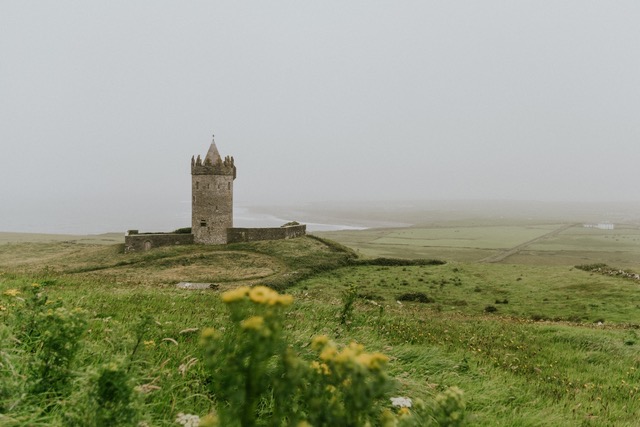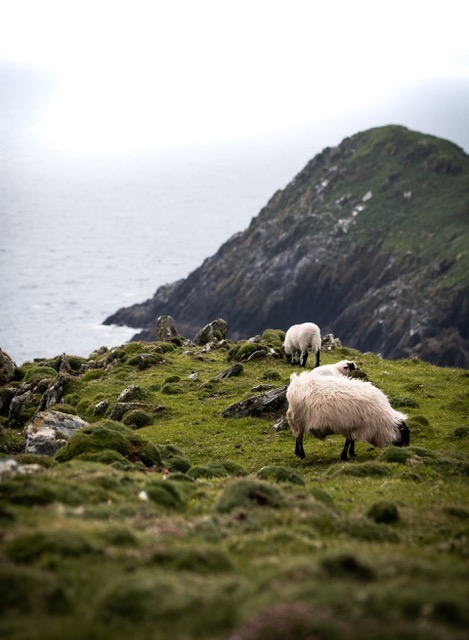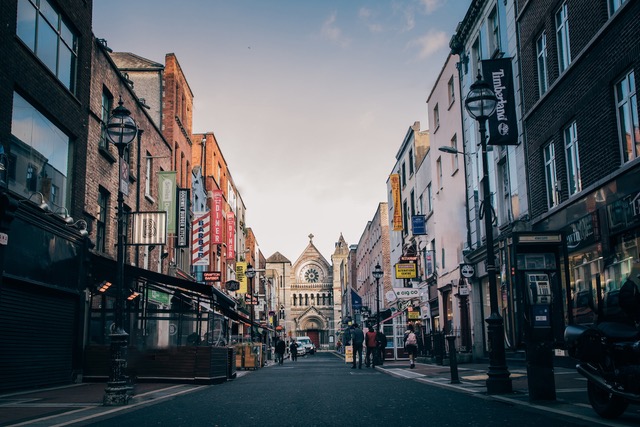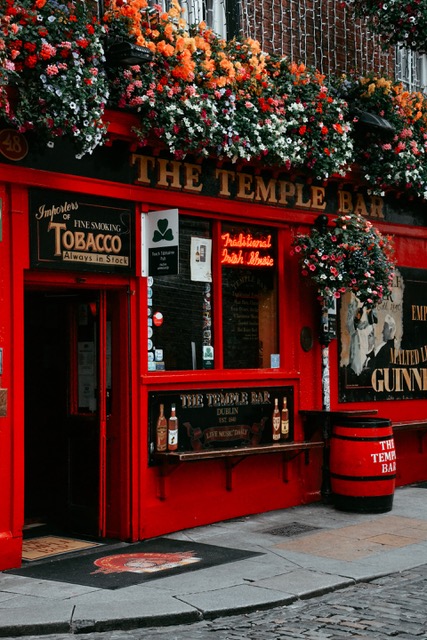Ireland is a place with a rich history as well as strong cultural and economic presence in our modern world. As I was preparing for a recent visit to “the Emerald Isle,” I enjoyed going deeper to learn more about Ireland and Dublin. It’s a place I’ve always enjoyed visiting. It always holds true that the more I learn about a destination the more I enjoy my time there. So let’s dig in and I’ll share some of the fun and fascinating things I learned about Ireland and Dublin. If you’re not inclined to read the history part of this article, please scroll down to the Fun Facts section and enjoy these fun facts about Ireland!
To begin: where is Ireland, exactly?
It occupies most of the westernmost major island of the British Isles. One of Ireland’s unique features is its impressive Atlantic coastline, stretching an expanse of 2,000 miles. Its rainy climate (resulting in rich green landscape) is why Ireland is sometimes called the Emerald Isle.
A Brief History of Ireland
Archaeologists think the first people to settle in Ireland arrived around 6000 B.C. By 3500 B.C. settlers used stone tools to clear farmlands. Around 700 B.C., the Celts, a diverse and technologically advanced culture from central Europe, began to settle on the island. They thrived there for nearly 2,000 years.
In the ninth century A.D., Viking invaders began raids into Ireland. They eventually established settlements that later became some of the country’s main cities, including the capital of Dublin.
These aggressive arrivals fought with the Celts for 200 years until a battle in 1014, known as the Battle of Clontarf, united the country. Peace broke down quickly, though, and Ireland was divided into many kingdoms.

In 1170, Norman Vikings who had taken control of England invaded Ireland and made it an English territory. In the early 1600s, England’s official religion became Protestant, while most Irish remained Roman Catholic. This created tensions that would eventually lead to revolution and Ireland’s independence.
By the 1820s, British laws unfair to Catholics had sparked a mass movement for Irish sovereignty. In 1829, many of those laws were overturned, but Ireland still wanted freedom. In 1922, after violent uprisings, the Irish Free State was created within the British Empire.
It was in 1948 that most of Ireland became an independent country, while six mainly Protestant counties in the northeast remained a British territory.
Explaining Sectarian Division
Here’s how the CIA Factbook explains sectarian division in Ireland. It’s complicated!
The modern Irish state traces its origins to the failed 1916 Easter Monday Uprising that galvanized nationalist sentiment and fostered a guerrilla war resulting in independence from the UK in 1921 with the signing of the Anglo-Irish Treaty and the creation of the Irish Free State.
The treaty was deeply controversial in Ireland, in part because it helped solidify the partition of Ireland, with six of the island’s 32 counties remaining in the UK as Northern Ireland.
The split between pro-Treaty and anti-Treaty partisans led to the Irish Civil War (1922-23). The traditionally dominant political parties in Ireland, Fine Gael and Fianna Fail, are de facto descendants of the opposing sides of the treaty debate. Ireland formally left the British Dominion in 1949 when Ireland declared itself a republic.

Beautiful scenery and animals dot the Irish countryside
Deep sectarian divides between the Catholic and Protestant populations and systemic discrimination in Northern Ireland erupted into years of violence known as the “Troubles” that began in the 1960s. In 1998, the governments of Ireland and the UK, along with most political parties in Northern Ireland, reached the Belfast/Good Friday Agreement with the support of the US. This agreement helped end the Troubles and initiated a new phase of cooperation between the Irish and British Governments.
Ireland was neutral in World War II and continues its policy of military neutrality. Ireland joined the European Community in 1973 and the euro-zone currency union in 1999. The economic boom years of the Celtic Tiger (1995-2007) saw rapid economic growth, which came to an abrupt end in 2008 with the meltdown of the Irish banking system.
As a small, open economy, Ireland has excelled at courting foreign direct investment, especially from US multi-nationals, which helped the economy recover from the financial crisis and insulated it somewhat from the economic shocks of the COVID-19 pandemic.
Discovering Dublin, Ireland
Dublin is located on the River Liffey, which flows eastward toward the Irish Sea. A bit of name trivia: dark water draining into the river formed a “black pool.” This is how Dublin was named.
Today Dublin suburbs extend into the surrounding countryside, but in centuries past you can imagine how the Nordic settlers were attracted to the region, including Viking raiders!
What’s so special about Dublin, Ireland?
The city is steeped in history. And the people are known for their friendliness and humor (sharp wit and irony).
Humans have dwelled around Dublin Bay since prehistoric times. Dublin was mentioned in the Greek Ptolemy’s early geography guide as early as 140 CE. Norse settlers (not Celtic, as many people believe) were the first to make their homes in the region.
As mentioned, the Norsemen (better known as Vikings) invaded in the 9th century, building fortresses along the river’s south bank. The Vikings fought other intruders (mainly the Irish) to control the land. Norse Dublin prospered through the 12th century, though the kings eventually lost their power to the Irish overlords.
Dublin remained a walled, medieval city through the 1600s. The city survived at least three uprisings, a Scottish siege, and the Black Death.
By the Reformation in the 16th century, Dublin became Protestant. During the English Civil Wars, the city’s royalist defenders decided against joining forces with an armed Irish Catholic confederacy and surrendered the city in 1649 to Oliver Cromwell’s English parliamentary army.
By the end of Cromwell’s era, only 9,000 inhabitants lived in the city. The turreted city wall with its eight gates was a shambles; the two cathedrals tottered, and the Dublin Castle was a wreck. Yet, in the 18th century Dublin was to become the second city of the British Empire.
What led to Dublin’s growth in the 17th century? Thousands of French Huguenot weavers fled France and settled in Ireland. Flemish weavers came next. Dublin’s cloth trade flourished (competing with Britain’s trade).

Dublin continued to grow in the 18th century as well, expanding buildings, roads, and bridges beyond the city’s medieval walls. Dublin became known for its culture and literature. Jonathan Swift was the dean of St. Patrick’s Cathedral, and Handel’s Messiah was first performed in Dublin in 1742. The city was vibrant, colorful, and elegant.
However, the Roman Catholics of Dublin (the majority religion) were repressed and disenfranchised. The Irish Parliament passed laws to keep Catholics from owning property, gaining education, and entering the professions. These laws resulted in the majority of Dubliners living in poverty.
Modern Times In Ireland And Dublin
Relations between England and Ireland continued to change during the 1800s. The Irish Parliament was abolished, and Dublin’s status diminished for the next century. Peasants moved into the city center, resulting in slums and ghettos.
The Irish Potato Famine of 1845-49 made matters even worse. Tens of thousands of peasants left the countryside to make their living in the city. Thousands of Irish people emigrated to the U.S. and other countries.
The conflict between Irish Catholics and Protestants continued to grow. A Roman Catholic middle class emerged in the mid-1800s, allowing Catholics to participate in Parliament and university life. Catholic churches and schools were built around the city.
Another step into modern times was the construction of the first railroad in Ireland in 1834. This led to the growth of suburbs along the south coast.
By the beginning of the 20th century, political tensions were high between Britain and Ireland. The Irish Party brought Home Rule to the country in 1914, but this was suspended during World War I. Even before the war, though, the Irish Republican Brotherhood (IRB) had been secretly organizing. Just after the war in 1916, the IRB, together with the Irish Volunteers militia, rebelled on Easter Monday. The Irish Republic was born……… but was soon defeated.
The Irish Republican Army (IRA) fought for sovereignty. A civil war raged through 1923, centered in Dublin. Political assassinations and raids continued into the 1930s. Between 1922 and 1932, the Irish Free State took command of the country. The new government cleaned up some of Dublin’s slums and created better housing projects on the outskirts of the city.
During World War II Ireland remained neutral, though German bombs did fall on Dublin. After the war, conditions improved in Dublin and throughout Ireland. High-rise apartments were built in nearby suburbs. Tourism grew.

Temple Bar in Dublin, Ireland
Pro Tip: Do you Pruvo all your hotels stays? If not, do what I do and let Pruvo monitor your reservations for price drops. It’s free and it’s the easiest way to save money on all your hotel rooms.
A Few Notable Sites
O’Connell’s Bridge divides the city into two parts, north and south. On the north visitors will find Georgian-style architecture. Some of the finest monumental buildings are found on the north riverbank, but you’ll also find some of the city’s poorest parts. This reflects a contrast between the politics and economic life of the past—aristocratic and impoverished—and prosperous Dublin today.
When you visit you will notice three architectural styles in Dublin: Georgian, Norse, and Norman. These styles culminate in the famous Dublin Castle—a main landmark of the city. The Georgians rebuilt the Norse (and formerly Norman) fortress out of red brick, though two of the original towers are still standing.
Other notable sites include Christ Church Cathedral (built originally around 1030 AD) and St. Patrick’s Cathedral. When brewing magnate Benjamin Lee Guinness became lord mayor of Dublin in 1851, he helped finance a restoration of the city.
Of course, the Guinness Brewery is a major tourist attraction today.
St. Stephen’s Green is the largest and oldest square in the city (established 1224).
Trinity College (now University of Dublin) was established in 1592, making it one of the oldest universities in Europe. It is home to the famous Book of Kells in Trinity College Library, an illuminated New Testament manuscript.
Bram Stoker (author of Dracula) is just one of the famous alumni of Trinity.
Dublin, Ireland: Economy and Culture Today
Traditional industries (Guinness Brewery, distilling, textile manufacturing, and food processing) have declined in the past 50 years, resulting in economic recession throughout Ireland. But economic conditions have improved since the 1990s, as new industry has grown, including information technology, engineering, and electronics.
Dublin is the center of Ireland’s financial and commercial enterprises, and it’s the home of the Irish Stock Exchange. Dublin is also governmental headquarters. The two houses of Irish parliament still meet at the famous Leinster House.
Dublin has been the center of culture in Ireland since the 1880s. The Gaelic League is an active group that promotes Irish language and folklore. The National Gallery and the Irish Museum of Modern Art are just two massive collections that celebrate the arts.
Three Nobel Prize winners were born in Dublin, Ireland! Can you name them?
[Samuel Beckett, George Bernard Shaw, and William Butler Yeats]
Other notable Irish writers are Jonathan Swift, Oscar Wilde, and James Joyce.
The Irish Pub
No account of Ireland would be complete without explaining the institution of the pub.
Pub culture is an essential part of life in Ireland. Historically, pubs, also known as public houses, were for working men. They could enjoy a drink together without the fees of exclusive private drinking clubs. Pubs also could include grocery and hardware sales. This helped pub owners make a living, especially through periodic temperance movements in Ireland, when less alcohol was consumed.
Pubs today tend to be independently owned in Ireland, though some are owned by a chain. Most pubs sell similar products. Most pubs also provide outdoor seating (because of Ireland’s indoor smoking ban).
Why are pubs so important to Irish culture? Over a drink or two, the Irish get to know each other and experience a level of community that we don’t usually find in American bars. There is a deep sense of camaraderie. Pubs serve as a type of community center.
Here’s my hotel choice when I’m in Dublin!
How the pub system works:
If you’re drinking in a group, typical pub etiquette involves buying the drinks in ’rounds.’ Each person in the group will purchase and pay for a drink for each drinker in their specific group.
The first round of drinks will be purchased by the first person to volunteer to start the evening off with a drink. Drinker number two will follow up and buy a drink for everyone. The system continues until everyone in the group has purchased a round of drinks for their companions.
The system goes on until the group stops drinking. But be fair warned! Try to finish up before a repeat-round gets going. It’s difficult to leave before you buy your obligatory round.
Beyond Dublin, Ireland
While Dublin is a “must-see” attraction for visitors, outside of this main city lies gorgeous, green, and peaceful countryside. Many Irish citizens live in the small villages throughout the remote countryside.
To envision the countryside, consider the nation’s topography.
The primary landmass of Ireland sits on a limestone plain. This plain is surrounded by coastal highlands. Irish countryside is particularly scenic because of its many lakes, bogs, ridges, and lowland areas. Yet Ireland also has several mountain ranges, including the Blue Stack Mountains in the north, the Wicklow Mountains in the east, the Knockmealdown Mountains in the south, and the Macgillycuddy’s Reeks in the southwest.
Why, in 2023, are villages considered to be “remote”?
The answer is related to the country’s infrastructure. Narrow country roads offer restricted access, and bus service throughout the country is also limited. If you want to experience the Irish countryside, you might just decide to rent a car (caution: Irish drivers, like the British, drive on the left side of the road!).
Outside of Dublin other population centers include Cork, Waterford, Wexford, Drogheda, Sligo, Limerick, and Galway.
A February article in The Guardian highlights 10 particularly charming villages (some with fewer than 200 residents).
Whether you visit a village in the hills, the lowlands, or the coast, you’ll most likely find several pubs, many sheep, green fields, and friendly people.
Did You Know?
Ireland is also known for a number of distinctive qualities. See what you think of these fun facts about Ireland.
Halloween Originated in Ireland.
Halloween may have Christian ties, with Allhallowtide beginning a three-day veneration of the dearly departed, but Halloween traditions as we know them begin with the Celtic festival of Samhain.
In Old Irish, this means “Summer’s End.” It features bonfires, terrifying masks, even more terrifying turnip lanterns, and amateur dress-ups.
St. Patrick Wasn’t Irish.
He was a regular Romano-British person kidnapped and sold into slavery by Irish raiders at age 16. At some point, he escaped and returned as a missionary to convert the Celtic polytheists of Ireland. Maybe. His life story is shrouded in mystery, but one thing’s for sure – he wasn’t Irish.
More Irish People Live Outside of Ireland than Inside the Country.
From around 1700, between nine and ten million Irish-born people emigrated. That’s way more than Ireland’s highest population of 8.4 million during the 1840s.
Today, around 80 million people worldwide claim Irish descent (including more than 36 million Americans). There’s even a government position dedicated to this – Minister of State for the Diaspora and International Development (30 Fun Facts)
The Shamrock Isn’t a Symbol of Ireland.
The Anglicised form of seamróg – which simply means “young clover” – the shamrock isn’t any more a national symbol of the Republic of Ireland than Guinness is. It’s linked to St Patrick, who’s often depicted preaching while holding a shamrock. The real symbol? A Gaelic harp (30 Fun Facts)
Ireland is the Only Country to Have a Musical Instrument as its National Symbol.
As a testament to the country’s love for music, Ireland boasts a harp as its national emblem. It dates back to the 13th century.
There are (an estimated) 30,000 Castles and Ruins in Ireland.
While Blarney Castle and Bunratty Castle are among the most famous, you can see literally thousands more. This huge number is likely the result of Ireland’s tumultuous history of conquest and unrest.
The Guinness World Records is Related to THE Guinness.
This began thanks to Sir Hugh Beaver, the Guinness brewer manager back in the 1950s. He went out shooting with friends, missed a shot, and got into an argument about what was the fastest game bird in Europe.
Later that evening, he and his friends tried to confirm the answer in reference books but realized it was impossible. Realizing people had these kinds of debates in pubs across Ireland, Sir Beaver decided that the idea of a Record Book would settle these debates. The original Google was born in 1955 (30 Fun Facts)
Ireland is the most successful country in the Eurovision Song Contest.
The nation has won a massive 7 times since the contest started in 1956. However, it has finished in the top 10 only once in the last 14 years.
Final Thoughts
Hopefully this post has explained Ireland’s complicated history and introduced you to lovely Dublin and beyond. Are you ready to experience the Emerald Isle? It’s a favorite destination of mine and I’m glad I returned to once again enjoy its magic. I love the parks and greens in Dublin! If you’re a coffee drinker and want to know my favorite spot, just ask 🙂
Related Articles:
- My Favorite Travel Resources and Products
- Do you find it difficult to book award flights with your miles and points? I do! That’s why I turn to Point.me. They get me great deals and save me money and time.
- I Always Get the Lowest Prices on Hotel Rooms: Here’s How!
- Staying healthy is key to enjoying your travels. Here’s my SECRET, and I’ve even got a 10% discount for my readers!
- 9 Awesome Travel Accessories To Pack for Your Next Trip
- Why use just any credit card when you can use one that earns miles and points? Don’t miss out on the BEST current travel credit card offers!
- What if you could learn everything you need to know about your destination in just 15 minutes? Here’s how!
The responses below are not provided or commissioned by the bank advertiser. Responses have not been reviewed, approved or otherwise endorsed by the bank advertiser. It is not the bank advertiser's responsibility to ensure all posts and/or questions are answered.